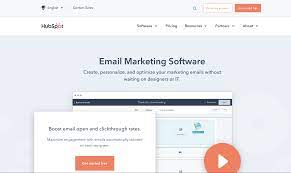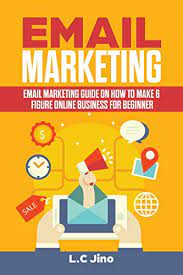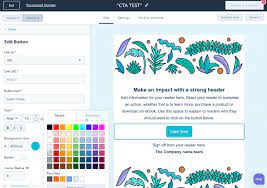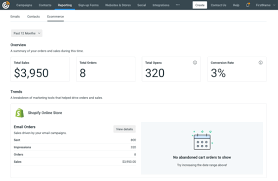Title: The Top Email Campaign Websites for Effective Marketing
Introduction:
In today’s digital world, email marketing continues to be a powerful tool for businesses to connect with their audience and drive conversions. To maximize the impact of your email campaigns, it’s crucial to choose the right platform. In this article, we will explore some of the best email campaign websites available, each offering unique features and benefits.
Mailchimp:
Mailchimp is a popular choice among marketers due to its user-friendly interface and robust features. It offers a drag-and-drop editor, automation tools, and advanced analytics. With Mailchimp, you can easily design visually appealing emails that engage your subscribers and track their interactions.
Constant Contact:
Constant Contact is renowned for its simplicity and ease of use. It provides a wide range of customizable templates, making it effortless to create professional-looking emails. Additionally, Constant Contact offers useful features such as list segmentation, A/B testing, and social media integration.
Sendinblue:
Sendinblue is an all-in-one marketing platform that includes email campaign management as one of its core features. Alongside email marketing tools, it also offers SMS marketing, live chat functionality, and CRM integration. Sendinblue’s intuitive interface makes it an ideal choice for both beginners and experienced marketers.
GetResponse:
GetResponse stands out with its comprehensive set of features designed to optimize email campaigns. It offers an easy-to-use drag-and-drop editor, autoresponders, landing page creation tools, and advanced analytics. GetResponse also provides webinar hosting capabilities—an added bonus for businesses looking to engage with their audience through live events.
Campaign Monitor:
Campaign Monitor is known for its beautiful templates that help businesses create visually stunning emails effortlessly. It offers an intuitive builder with customization options suitable for both beginners and advanced users alike. Additionally, Campaign Monitor provides robust automation features that allow you to personalize your campaigns based on customer behavior.
AWeber:
AWeber is a trusted name in the email marketing industry, known for its reliability and excellent customer support. It offers a range of templates, automation tools, and split-testing features. AWeber also integrates seamlessly with various e-commerce platforms, making it a top choice for online businesses.
Conclusion:
When it comes to email campaign websites, these are just a few of the best options available. Each platform offers unique features and benefits that cater to different business needs. Remember to consider factors such as ease of use, customization options, automation capabilities, and analytics when choosing the right platform for your email marketing campaigns. By leveraging these powerful tools effectively, you can engage your audience and achieve your marketing goals with ease.
7 Essential Tips for Successful Email Campaigns: A Guide to Choosing the Best Email Service Provider and Optimizing Your Strategy
- Use a professional email service provider to ensure your emails are delivered quickly and reliably.
- Make sure the design of your email is optimised for mobile devices as well as desktop computers.
- Personalise your emails with each recipient’s name, where possible, to make them feel more personal and engaging.
- Include a clear call-to-action in each email to encourage people to take action after reading it.
- Test different subject lines to see which ones get the best open rates from recipients before you send out your campaign in full.
- Monitor the performance of your campaigns with analytics tools so you can improve future campaigns based on data-driven insights
- Segment your contact list into smaller groups according to their interests or behaviour so you can target them more effectively with tailored content that resonates better with them
Use a professional email service provider to ensure your emails are delivered quickly and reliably.
Title: Enhance Your Email Campaign Success with a Professional Email Service Provider
In the world of email marketing, the success of your campaigns heavily relies on the delivery and reliability of your messages. To ensure your emails reach their intended recipients promptly and consistently, it is crucial to utilize a professional email service provider (ESP). These platforms offer a range of features and benefits that can significantly enhance your email campaign performance.
One of the key advantages of using a professional ESP is their robust infrastructure and dedicated email delivery systems. These providers have invested heavily in building reliable networks that can handle large volumes of emails efficiently. By leveraging their infrastructure, you can rest assured that your messages will be delivered promptly, reducing the risk of delays or undelivered emails.
Moreover, professional ESPs often have established relationships with major internet service providers (ISPs) and email clients. This means they have a higher chance of bypassing spam filters and landing directly in the inbox rather than being flagged as junk or promotional content. This increased deliverability ensures that your carefully crafted emails are more likely to be seen by your target audience.
Another benefit offered by professional ESPs is advanced tracking and analytics capabilities. These tools provide valuable insights into how recipients engage with your emails. You can monitor open rates, click-through rates, and other metrics to gauge the effectiveness of your campaigns. Armed with this data, you can make informed decisions about optimizing future campaigns for better results.
Furthermore, professional ESPs often offer features such as list segmentation and personalization options. These tools allow you to tailor your messages based on specific demographics or customer preferences, resulting in more targeted and relevant communications. By sending personalized content to segmented groups within your subscriber list, you increase the chances of engagement and conversion.
Lastly, using a professional ESP demonstrates professionalism and builds trust with your subscribers. When recipients see that you are using a reputable service provider to manage your email campaigns, they are more likely to view your messages as legitimate and trustworthy. This can lead to higher open rates, increased click-through rates, and ultimately, a stronger connection with your audience.
In conclusion, choosing a professional email service provider is a vital step towards ensuring the success of your email campaigns. These platforms offer reliable delivery systems, advanced analytics, personalization options, and enhanced deliverability. By leveraging their features and benefits, you can optimize your email marketing efforts and achieve better engagement and conversions. So, invest in a professional ESP today to take your email campaigns to new heights of success.
Make sure the design of your email is optimised for mobile devices as well as desktop computers.
Title: Optimizing Email Designs for Mobile Devices and Desktop Computers
In today’s digital era, where most people access their emails on mobile devices, it is essential to ensure that your email campaigns are optimized for both mobile and desktop users. Neglecting mobile optimization can result in a poor user experience, leading to lower engagement and conversion rates. Here’s why you should prioritize designing emails that work seamlessly across all devices.
Mobile Usage is on the Rise:
With the increasing popularity of smartphones and tablets, more and more people are accessing their emails on mobile devices. In fact, studies show that over 50% of emails are opened on mobile devices. Ignoring this significant portion of your audience can greatly hinder the success of your email campaigns.
Responsive Design:
To cater to users across different devices, implementing responsive design is crucial. Responsive design ensures that your email adapts to fit the screen size of the device being used, whether it’s a smartphone, tablet, or desktop computer. This means that your message will be displayed optimally, regardless of the device being used.
User Experience Matters:
Mobile users have different needs compared to desktop users. They often have limited screen space and may be viewing emails on-the-go or in a hurry. Optimizing your email design for mobile devices ensures that your content is easily readable with clear calls-to-action (CTAs) and minimal scrolling or zooming required. A seamless user experience encourages engagement and increases the likelihood of conversions.
Consistent Branding:
Maintaining consistent branding across all devices is essential for building trust and recognition with your audience. By ensuring a consistent design experience between mobile and desktop versions of your emails, you reinforce brand identity and professionalism.
Testing is Key:
Before sending out any email campaign, it’s crucial to thoroughly test it across various devices and email clients to ensure optimal display and functionality. This includes testing on popular platforms such as iOS and Android devices, as well as different email clients like Gmail, Outlook, and Apple Mail.
In conclusion, optimizing your email designs for mobile devices as well as desktop computers is vital for the success of your email campaigns. By implementing responsive design, considering user experience, maintaining consistent branding, and conducting thorough testing, you can ensure that your messages reach and engage your audience effectively across all devices. Don’t overlook the mobile audience – embrace it to maximize the impact of your email marketing efforts.
Personalise your emails with each recipient’s name, where possible, to make them feel more personal and engaging.
Title: Enhance Email Engagement with Personalized Content
In the world of email marketing, personalization is a game-changer. By addressing your recipients by their names and tailoring your content to their interests, you can create a more engaging and impactful email campaign. Let’s delve into why personalization matters and how it can be achieved using the best email campaign websites.
Personalization is Key:
When recipients see their names in the subject line or body of an email, it instantly grabs their attention. It makes them feel acknowledged and valued as individuals rather than just another name on a mailing list. Personalized emails have been proven to have higher open rates, click-through rates, and conversion rates compared to generic mass emails.
Using the Right Tools:
To implement personalization effectively, you need an email campaign website that supports this feature. Fortunately, many top platforms offer dynamic content options that allow you to insert recipient-specific details seamlessly.
Segmentation:
Start by segmenting your email list based on various criteria such as demographics, purchase history, or engagement level. This way, you can tailor your messages to specific groups with similar interests or needs.
Merge Tags:
Most leading email campaign websites provide merge tag functionality. Merge tags enable you to insert dynamic content into your emails automatically. The most common merge tag is “First Name,” which allows you to address each recipient individually. However, you can also use other merge tags like “Location” or “Recent Purchase” to personalize further based on available data.
Automation:
Utilize automation tools available on these platforms to set up personalized email sequences triggered by specific actions or events. For example, if a customer abandons their cart on your e-commerce site, an automated follow-up email can remind them about the items left behind and even offer an exclusive discount code for completion.
Testing and Optimization:
To ensure the effectiveness of personalization efforts, conduct A/B testing with different personalized elements in your emails. Test variations of subject lines, content, or call-to-action buttons to see what resonates best with your audience. Use the analytics provided by the email campaign website to track open rates, click-through rates, and conversions.
Conclusion:
Personalization is a powerful tool in email marketing that can significantly enhance engagement and conversion rates. By using the best email campaign websites that support personalization features, you can address recipients by their names and customize content based on their interests and behaviors. Take advantage of segmentation, merge tags, automation, testing, and optimization to create impactful email campaigns that make each recipient feel valued and connected to your brand.
Include a clear call-to-action in each email to encourage people to take action after reading it.
Title: The Power of a Clear Call-to-Action in Email Campaigns
Introduction:
In the world of email marketing, crafting compelling content is essential to engage your audience. However, it’s equally crucial to guide them towards taking action after reading your emails. One effective way to achieve this is by including a clear call-to-action (CTA) in each email. In this article, we will explore the importance of CTAs and how they can boost the success of your email campaigns.
The Importance of a Clear Call-to-Action:
A call-to-action serves as a prompt for your recipients to take a specific action after reading your email. Whether it’s making a purchase, signing up for an event, or subscribing to a newsletter, a well-crafted CTA directs your audience towards the desired outcome. By including a clear and compelling CTA, you encourage engagement and increase conversion rates.
Tips for Creating an Effective Call-to-Action:
Be Clear and Concise: Make sure your CTA stands out by using bold fonts or buttons that catch the reader’s attention. Use concise and action-oriented language that clearly communicates what you want them to do.
Create Urgency: Incorporate words that instill a sense of urgency or exclusivity in your CTA. Phrases like “Limited Time Offer” or “Last Chance” can motivate readers to take immediate action.
Use Strong Verbs: Start your CTA with strong verbs that encourage action, such as “Shop now,” “Subscribe today,” or “Register now.” These verbs create momentum and inspire readers to act promptly.
Offer Incentives: Provide additional motivation by offering incentives like discounts, freebies, or exclusive access when users click on your CTA. This can significantly increase click-through rates and conversions.
Test and Optimize: Experiment with different CTAs to see which ones resonate best with your audience. A/B testing can help you identify the most effective wording, design, and placement for your CTAs.
Benefits of Including a Clear Call-to-Action:
Increased Engagement: A well-placed and compelling CTA prompts readers to interact with your brand, leading to higher engagement rates.
Higher Conversion Rates: When your CTA clearly communicates the desired action, readers are more likely to follow through, resulting in increased conversions and sales.
Improved User Experience: By providing a clear path for users to follow, you enhance their experience with your brand, making it easier for them to navigate and interact with your offerings.
Conclusion:
Incorporating a clear call-to-action in each email is a powerful strategy to drive action from your audience. By crafting compelling CTAs that are concise, urgent, and action-oriented, you can boost engagement levels, increase conversion rates, and create a seamless user experience. Remember to continuously test and optimize your CTAs to ensure they resonate with your target audience. With this simple yet effective technique, you can take your email campaigns to new heights of success.
Test different subject lines to see which ones get the best open rates from recipients before you send out your campaign in full.
Title: Boost Email Open Rates with Subject Line Testing
Introduction:
In the world of email marketing, crafting compelling subject lines is crucial to capturing the attention of recipients and driving higher open rates. One effective strategy to optimize your email campaigns is to test different subject lines before sending them out to your entire subscriber list. By doing so, you can determine which subject lines resonate best with your audience and significantly improve your open rates. In this article, we will explore the importance of subject line testing and how it can benefit your email campaigns.
Why Test Subject Lines?
Subject lines act as gateways to your emails, influencing recipients’ decision to open or ignore them. Testing different subject lines allows you to gather valuable data on what works best for your specific audience. It helps you understand their preferences, language, and what ultimately grabs their attention. By identifying high-performing subject lines through testing, you can optimize future campaigns and increase engagement.
How to Test Subject Lines:
Segment Your Audience: Divide your subscriber list into smaller segments based on demographics, interests, or engagement levels. This allows you to target specific groups with different subject lines.
A/B Testing: Select two or more variations of subject lines for each segment and send out emails with these different versions simultaneously. Monitor the open rates for each variation.
Analyze Results: After a sufficient sample size has been reached, compare the open rates for each variation within each segment. Identify which subject lines performed best in terms of open rates.
Iterate and Optimize: Use the insights gained from the testing phase to refine future email campaigns by incorporating successful subject line elements that resonate well with your audience.
Benefits of Subject Line Testing:
Improved Open Rates: By testing subject lines beforehand, you can identify those that generate higher open rates among different segments of your audience. This enables you to send out emails with confidence, knowing that they have a better chance of being opened and read.
Increased Engagement: Engaging subject lines pique recipients’ curiosity and encourage them to explore the content of your emails. Testing helps you find the language, tone, and keywords that resonate best with your audience, leading to increased engagement and interaction.
Higher Conversion Rates: When more recipients open your emails, it increases the likelihood of achieving your campaign objectives. Whether it’s driving website traffic, promoting a product or service, or encouraging sign-ups, higher open rates can lead to improved conversion rates.
Conclusion:
Subject line testing is an essential practice for any email marketer seeking to optimize their campaigns. By experimenting with different subject lines and analyzing the results, you can gain valuable insights into what captures your audience’s attention. With this knowledge in hand, you can refine your subject lines to boost open rates, increase engagement, and ultimately drive better results from your email campaigns. Remember, testing is an ongoing process that allows you to continuously improve and adapt to the ever-changing preferences of your subscribers.
Monitor the performance of your campaigns with analytics tools so you can improve future campaigns based on data-driven insights
Title: Enhance Your Email Campaign Success with Data-Driven Insights
In the ever-evolving landscape of digital marketing, it is crucial to continuously improve and refine your email campaigns to achieve optimal results. One powerful way to accomplish this is by monitoring the performance of your campaigns using analytics tools. By leveraging data-driven insights, you can gain a deeper understanding of your audience’s preferences and behaviors, enabling you to enhance future campaigns for maximum impact.
Analytics tools provide valuable information about the performance of your email campaigns. They offer metrics such as open rates, click-through rates, bounce rates, and conversion rates. These metrics help you gauge the effectiveness of your campaigns and identify areas for improvement. Here’s why monitoring campaign performance with analytics tools is essential:
- Track Engagement: Analytics tools allow you to measure how engaged your audience is with your emails. By monitoring open rates and click-through rates, you can determine which subject lines, content, or calls-to-action resonate most with your subscribers. This information empowers you to make data-backed decisions when crafting future campaigns.
- Identify Pain Points: Analytics tools provide insights into where potential issues lie within your email campaigns. High bounce rates may indicate problems with list quality or deliverability, while low conversion rates could point to ineffective landing pages or weak calls-to-action. Identifying these pain points enables you to address them promptly and optimize campaign performance.
- Refine Segmentation: Email campaign analytics allow you to segment your audience based on various factors such as demographics, engagement levels, or purchase history. Analysing the performance of different segments helps you understand which groups respond best to specific messaging or offers. This knowledge allows for more targeted and personalized campaigns that yield higher engagement and conversions.
- Test and Iterate: With analytics tools at hand, you can conduct A/B tests on different elements of your emails like subject lines, visuals, or CTAs. By comparing the performance of different variations, you can identify the most effective elements and refine your campaigns accordingly. This iterative approach ensures continuous improvement and maximizes the impact of your email marketing efforts.
- Measure ROI: Analytics tools provide insights into the return on investment (ROI) of your email campaigns. By tracking conversions and revenue generated from your email marketing efforts, you can determine the effectiveness of your campaigns in driving tangible business outcomes. This data helps justify investments in email marketing and guides future budget allocation.
In conclusion, monitoring the performance of your email campaigns with analytics tools is a fundamental practice for any marketer aiming to achieve success. By harnessing data-driven insights, you can make informed decisions, refine your strategies, and create more engaging and impactful campaigns. Embrace the power of analytics to unlock the full potential of your email marketing efforts and drive meaningful results for your business.
Segment your contact list into smaller groups according to their interests or behaviour so you can target them more effectively with tailored content that resonates better with them
Segmenting your contact list into smaller groups based on interests and behavior is a valuable strategy to enhance the effectiveness of your email campaigns. By tailoring your content to specific audience segments, you can deliver messages that resonate better with their needs and preferences. This targeted approach not only increases engagement but also improves the chances of conversion.
When you segment your contact list, you create subsets of subscribers who share common characteristics or interests. For example, you can group customers who have purchased a specific product or service together or categorize subscribers based on their engagement levels with previous emails. By doing so, you gain valuable insights into their preferences, allowing you to craft more personalized and relevant content.
Segmentation enables you to send highly targeted emails that address the specific pain points or desires of each group. For instance, if you have a segment interested in a particular product category, you can create campaigns highlighting new releases or exclusive offers related to that category. By delivering content that aligns with their interests, you increase the likelihood of capturing their attention and driving conversions.
Moreover, segmentation allows for more effective A/B testing. You can experiment with different subject lines, layouts, or calls-to-action within each segment to determine what resonates best with them. This data-driven approach helps refine your email campaigns over time by identifying the elements that generate higher open rates and click-through rates for each group.
Segmentation also plays a crucial role in maintaining a positive user experience. When subscribers receive content that is tailored to their needs and preferences, they feel valued and understood as individuals rather than just another name on a mailing list. This personal touch builds trust and strengthens the relationship between your brand and its audience.
To implement effective segmentation strategies, consider utilizing an email campaign website that offers robust list management tools. Look for platforms that allow easy creation of dynamic segments based on various criteria such as purchase history, engagement metrics, demographics, or survey responses.
In conclusion, segmenting your contact list into smaller groups based on interests and behavior is a powerful technique to enhance the effectiveness of your email campaigns. By delivering tailored content that resonates better with each segment, you can increase engagement, conversions, and ultimately build stronger relationships with your subscribers. Embrace the power of segmentation and watch your email marketing efforts yield impressive results.




